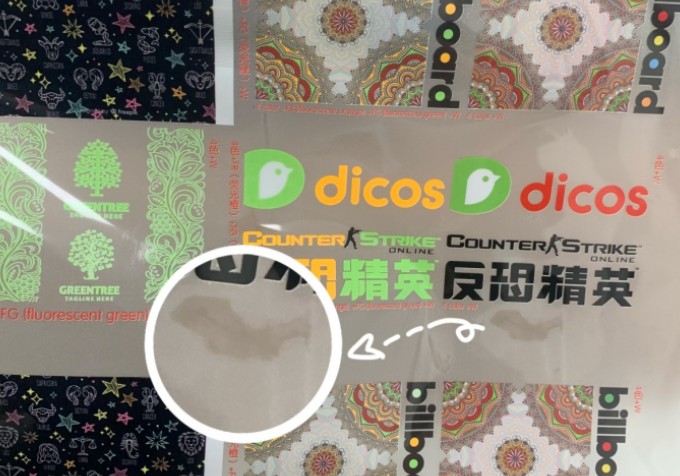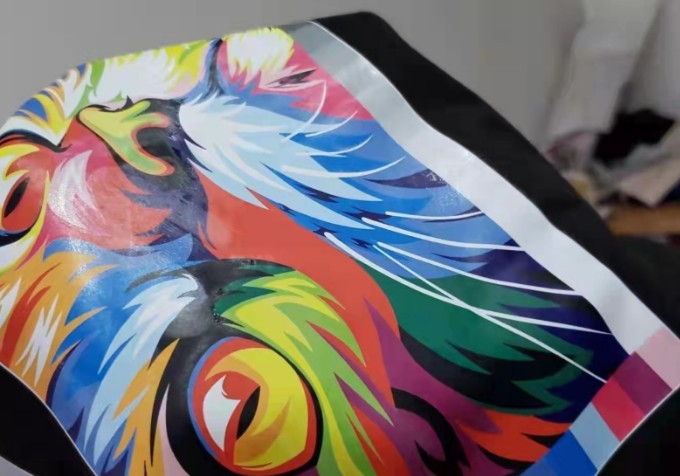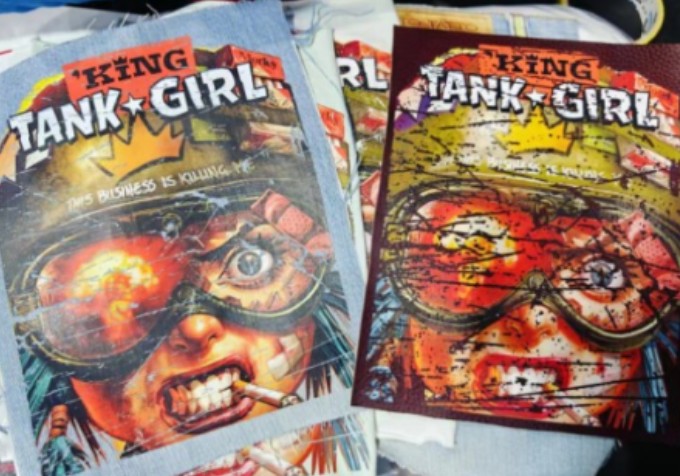DTF Printing is a special hot transferring technology that uses specialized DTF machines and supporting consumables to hot stamp patterns onto clothing and other materials. Compared with traditional printing technology, it has the advantages of distinctive patterns, good durability, high breathability and the ability to realize complex designs. Today we will explain to you some common questions: Why does dtf printing film become oily? How should this situation be resolved?
 Let’s first understand the reasons:
Let’s first understand the reasons:
There are many reasons why dtf printing film becomes oily.
Reason 1: Additive components in the ink.
DTF white ink contains an ingredient we call a humectant. Its function is to prevent the printhead from clogging. The main ingredient in moisturizers is glycerin. Glycerin is a clear, odorless, viscous liquid. It absorbs moisture from the air. Therefore, glycerin is a great moisturizer. Glycerol is miscible with water and ethanol, and its aqueous solution is neutral. At the same time, glycerin will not react with other ingredients in DTF white ink, thereby affecting the quality of the ink. Due to its physical properties, glycerin cannot be dried. If the drying process is not sufficient, glycerol will appear on the DTF transfer film after a period of time. And it will look oily.
Reason 2: The temperature is not enough.
While the powder is curing, determine the temperature and heating time.
Reason 3: Non-breathable fabrics can easily cause oil seepage on the surface.
Solution:
For DTF printer workplaces, if the weather gets significantly colder or warmer, all doors and windows should be closed immediately. And try not to turn on the exhaust fan to avoid sucking humid air from outside into the room.
Generally we will recommend customers to install air conditioning in the white ink printer studio. Whenever humid weather arrives, you can turn on the air conditioner for dehumidification. Or you can use a dehumidification studio for dehumidification.
When storing printed films, extra care needs to be taken to protect them from moisture. Printed films easily absorb moisture and are affected by humidity. The printing film is affected by moisture and is prone to ink scattering and printing pattern oil return. Therefore, the printing film should be returned to the original packaging after each use. And try not to touch the floor and walls. If there is no packaging bag, you can wrap the bottom of the film, seal it and store it in a ventilated and dry place.
After understanding the oil return, let’s briefly understand the following causes and solutions of foaming.
 Why does dtf printing become bubble?
Why does dtf printing become bubble?
As we all know, printers with heating capabilities can cure 40-50% of the white ink before the film enters the powder machine. Then adjust the constant temperature to 110~140°C. Under this condition, the powder will melt and serve as a primer, and 30~40% water will remain in the white ink (between the PET film and the powder primer). Water inside may condense and cause blisters or blisters.
Some people may say that water does not appear often. In fact, it depends on two points-one is the humidity of your exhibition hall, and the other is the quality of your film. A high-quality film has strong water absorption, which helps the film to dry as much as possible.
TEXTEK can provide you with high-quality cold peel film or hot peel film according to your needs.
How to avoid this problem?
If the powder machine manufacturer can divide the drying area into three stages, this problem can be avoided with the greatest probability. In the first stage, we can control the temperature at 110°C. At this time, the powder has just begun to melt and the water will turn into gas and escape. In the second stage, we can set the temperature to 120~130℃ to heat the glycerin. Then in the third stage, the temperature can be 140°C, allowing the powder to completely melt and act as a primer to bond with the image.
 In the final analysis, this series of issues are actually closely related to the environment, processes and materials.
In the final analysis, this series of issues are actually closely related to the environment, processes and materials.
Environment factor
In a humid environment, the dtf film is prone to moisture, causing the ink to condense on the dtf film, resulting in ink droplets being unable to spread evenly and oil return. In addition, a humid environment can easily cause the dtf printer print head clog, thus affecting the printing effect. Therefore, in order to maintain the quality and effect of dtf printing, it is necessary to avoid using the machine in a humid environment.
Process factor
The DTF film is composed of a printing film and a heat transfer film. The color ink layer and the white ink layer are formed through inkjet printing, and the glue powder layer is formed through a dusting, shaking and drying process. Among them, colored ink and white ink are water-based materials that contain a lot of water and require sufficient time and temperature to dehydrate and dry. The rubber powder is an oily resin material. During the drying and film-forming process, the rubber powder can easily melt and form a film.
To put it simply, the phenomenon of oil return and bubbling in heat transfer is caused by the fact that the water in the ink is not completely dried and accumulates between the PET printing film and the glue powder layer and cannot escape. Therefore, in this case, you need to choose a high-quality dtf machine and use correct printing techniques to thoroughly dry the heat transfer film to prevent such problems from occurring.
Material factor
The impact of materials on the quality of dtf printing is self-evident. It has a huge impact on the color accuracy, detail expression, durability, and even the feel of the finished product.
Here, we should pay special attention to the storage and selection of printing DTF PET film and ink.
Since printing films easily absorb water, you should pay more attention to moisture-proofing when storing dtf films. The printing film should be returned to the original packaging after each use, and should be kept away from the ground and walls as much as possible. If there is no packaging bag, you can wrap the bottom of the film, seal it and store it in a ventilated and dry place.
Use high-quality ink. Choosing good-quality ink can reduce the occurrence of oil return, because good-quality ink has better permeability and stability.
So how to avoid these problems in dtf printing?
1. Open windows frequently for ventilation: it can maintain indoor air circulation and prevent moist air from being retained indoors, thus reducing the chance of dtf printing getting damp.
2. Use a dehumidifier: In humid seasons or areas, you can use a dehumidifier to reduce indoor humidity, thus reducing the possibility of dtf printing getting damp.
3. Properly control the printing temperature: Too high a printing temperature will cause the ink to evaporate too quickly, easily forming water droplets on the printing film, resulting in oil return. Therefore, during the printing process, the printing temperature should be appropriately controlled.
4. Avoid over-printing: Over-printing will cause too much ink to remain on the printing film, which is prone to moisture and oil return. Therefore, during the printing process, the amount of ink used should be controlled to avoid over-printing.
5. Clean the printhead regularly: Cleaning the printhead regularly can keep the print head in good condition and avoid excessive ink residue on the printing film due to clogging of the printhead.
6. Avoid placing dtf printing in humid places: You should avoid placing dtf printing in damp places, such as basements or bathrooms, because moisture in these places can easily penetrate into the dtf printing, causing dampness.
In summary, to prevent oil return in dtf printing, you need to start from many aspects and take good care of the machine to get a perfect finished product!
TEXTEK's business covers many countries around the world, including emerging markets and mature markets. We have a complete sales system and are committed to using our professional knowledge and first-class service to help customers improve their digital printing business.
.jpg)



.jpg)
